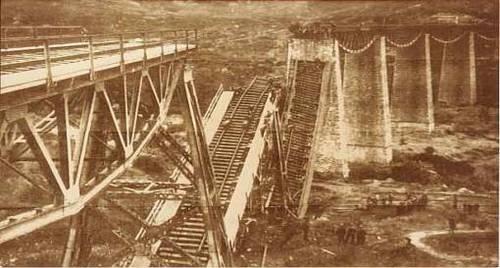The Gorgonpotamos viaduct blown up in 1942 by SOE and subsequently rebuilt.
Code name for the first Special Operations Executive (SOE) mission to the mainland of Greece, in September 1942, led by Brigadier Edmund Myers of the Royal Engineers. Harling resulted in contact with the Communist-dominated Greek army of national liberation, ELAS, and the demolition of the Gorgopotamus Bridge in November. Myers was an unlikely candidate for the mission, his only tenuous connection with SOE being that he was courting, and was later to marry, Bickham Sweet-Escott’s sister Louisa. A professional soldier who had recently been through the Middle East Staff College in Haifa and the Combined Operations parachute course at Suez, in September 1942 he had been scheduled to return to England. Instead, Colonel William Hamilton, an acquaintance and senior member of SOE Cairo’s staff, persuaded him to volunteer for harling. Myers spoke no Greek and his local knowledge was “limited to a few hours in Athens and Dubrovnik.” Nevertheless, Hamilton assured him that this was plenty of experience by SOE’s standards and gave him four days to prepare himself for his mission.
Myers’s objective, the Gorgopotamus viaduct, was one of three bridges that carried the main railway through Greece to the port of Piraeus. The Afrika Korps was heavily dependent upon this supply route, and the Royal Air Force had been unable to prevent its supply ships from dashing across from Crete to Tobruk and Benghazi under cover of darkness. Having failed to sink General Erwin Rommel’s ships, GHQ Middle East asked SOE to destroy the vital railway link somewhere between Salonika and Athens. General Alexander’s request, in anticipation of the Eighth Army’s offensive at El Alamein scheduled for mid-October, was relayed to SOE’s main source in Athens, Captain Koutsoyiannopoulos of the Royal Hellenic Navy, known as Prometheus II, who was operating a radio left by SOE during the evacuation of Athens. His reply, received in Turkey and couriered to Cairo in September confirmed that such an operation was possible and recommended that about 10 parachutists equipped with sabotage materiel be dropped between the end of September and early October.
Of the 12 SOE men due to land on the appointed evening from three Liberators, only eight actually parachuted on the last night of September, and of them only four could speak any Greek. The third aircraft had failed to find the drop zone and had returned to Egypt. Two further attempts were abandoned because of bad weather and eventually, some six weeks later, the last contingent landed in the Karpenisi Valley, miles away from the rest of the group and on the outskirts on a town under Italian occupation. The garrison opened fire and the SOE parachutists had fled, abandoning their containers to the Italians. Despite the fact that plans of their target had been packed in one of the containers and must have fallen into enemy hands, the operation went ahead, but without the expected support of dozens of local guerrillas, who simply failed to materialize. Clearly Prometheus II had exaggerated the number of pro-Allied guerrillas in the area, and SOE Cairo had been unable to double-check his information. Once Myers assembled his party and established contact with a band of local guerrillas known as andartes, he led an assault on the Italian garrison guarding the bridge and engaged the enemy for an hour while Tom Barnes, “a delightfully bluff and direct New Zealander,” and John Cook laid their demolition charges. When the raiders eventually withdrew, having suffered only four wounded, several of the bridge’s steel spans had been dropped into the gorge 40 feet below.
The operation had taken place about a month late, long after the big armored push at El Alamein but, says Monty Woodhouse, “It showed for the first time in occupied Europe that guerrillas, with the support of allied officers, could carry out a major tactical operation coordinated with allied strategic plans.”
Despite the apparent belated success of harling, which cut the vital rail link to Germany for a crucial six weeks, the rest of the operation was not to go well. No submarine turned up to collect Myers at the appointed time, and Cairo sent a signal explaining that, owing to the loss of another submarine in the vicinity, it was too risky to collect his team-which, because of the appearance of a pair of escaped Cypriot PoWs, had grown to more than a dozen. While this did not matter to Woodhouse and his two wireless operators, Sergeants Len Wilmott and Doug Phillips, who had always intended to remain in Greece as liaison officers with the local guerrillas, Myers had not bargained for this extended undertaking. Nor, for that matter, had he been briefed for it. Even from what Myers had witnessed during the three months he had spent involuntarily in the mountains, “it was apparent that the authorities in the Middle East knew little about the military strength and composition” of the local resistance movements.
Moreover, although we had one or two agents in Athens who were in touch by runner with some of the andarte bands in the field and by wireless with the Middle East, SOE Cairo had obviously been told little about the political aspects of the Greek resistance movements. The Greek government in London . . . probably knew little more than SOE and the Middle East Command.
Following the success of harling, the Germans took 300 Greek army reserve officers hostage and shot 50 of them as a reprisal.
